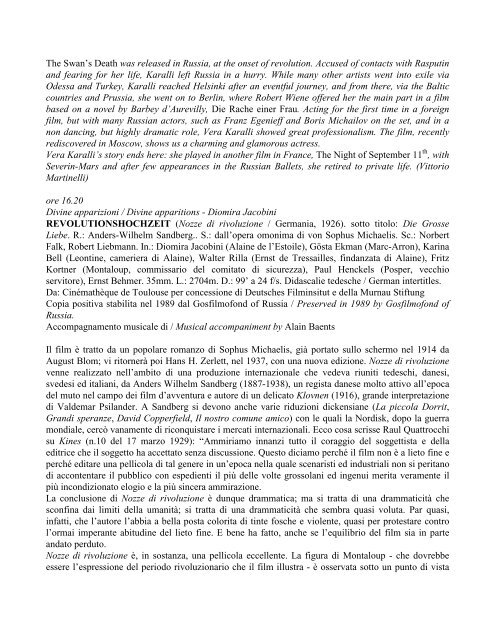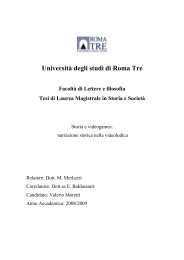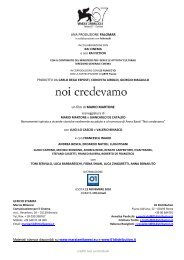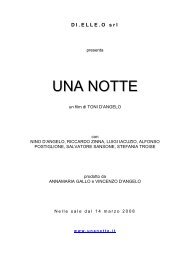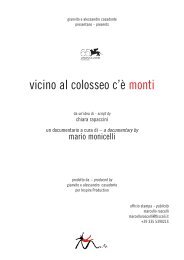Catalogo 1999 - Cineteca di Bologna
Catalogo 1999 - Cineteca di Bologna
Catalogo 1999 - Cineteca di Bologna
You also want an ePaper? Increase the reach of your titles
YUMPU automatically turns print PDFs into web optimized ePapers that Google loves.
The Swan’s Death was released in Russia, at the onset of revolution. Accused of contacts with Rasputin<br />
and fearing for her life, Karalli left Russia in a hurry. While many other artists went into exile via<br />
Odessa and Turkey, Karalli reached Helsinki after an eventful journey, and from there, via the Baltic<br />
countries and Prussia, she went on to Berlin, where Robert Wiene offered her the main part in a film<br />
based on a novel by Barbey d’Aurevilly, Die Rache einer Frau. Acting for the first time in a foreign<br />
film, but with many Russian actors, such as Franz Egenieff and Boris Michailov on the set, and in a<br />
non dancing, but highly dramatic role, Vera Karalli showed great professionalism. The film, recently<br />
re<strong>di</strong>scovered in Moscow, shows us a charming and glamorous actress.<br />
Vera Karalli’s story ends here: she played in another film in France, The Night of September 11 th , with<br />
Severin-Mars and after few appearances in the Russian Ballets, she retired to private life. (Vittorio<br />
Martinelli)<br />
ore 16.20<br />
Divine apparizioni / Divine apparitions - Diomira Jacobini<br />
REVOLUTIONSHOCHZEIT (Nozze <strong>di</strong> rivoluzione / Germania, 1926). sotto titolo: Die Grosse<br />
Liebe. R.: Anders-Wilhelm Sandberg.. S.: dall’opera omonima <strong>di</strong> von Sophus Michaelis. Sc.: Norbert<br />
Falk, Robert Liebmann. In.: Diomira Jacobini (Alaine de l’Estoile), Gösta Ekman (Marc-Arron), Karina<br />
Bell (Leontine, cameriera <strong>di</strong> Alaine), Walter Rilla (Ernst de Tressailles, findanzata <strong>di</strong> Alaine), Fritz<br />
Kortner (Montaloup, commissario del comitato <strong>di</strong> sicurezza), Paul Henckels (Posper, vecchio<br />
servitore), Ernst Behmer. 35mm. L.: 2704m. D.: 99’ a 24 f/s. Didascalie tedesche / German intertitles.<br />
Da: Cinémathèque de Toulouse per concessione <strong>di</strong> Deutsches Filminsitut e della Murnau Stiftung<br />
Copia positiva stabilita nel 1989 dal Gosfilmofond of Russia / Preserved in 1989 by Gosfilmofond of<br />
Russia.<br />
Accompagnamento musicale <strong>di</strong> / Musical accompaniment by Alain Baents<br />
Il film è tratto da un popolare romanzo <strong>di</strong> Sophus Michaelis, già portato sullo schermo nel 1914 da<br />
August Blom; vi ritornerà poi Hans H. Zerlett, nel 1937, con una nuova e<strong>di</strong>zione. Nozze <strong>di</strong> rivoluzione<br />
venne realizzato nell’ambito <strong>di</strong> una produzione internazionale che vedeva riuniti tedeschi, danesi,<br />
svedesi ed italiani, da Anders Wilhelm Sandberg (1887-1938), un regista danese molto attivo all’epoca<br />
del muto nel campo dei film d’avventura e autore <strong>di</strong> un delicato Klovnen (1916), grande interpretazione<br />
<strong>di</strong> Valdemar Psilander. A Sandberg si devono anche varie riduzioni <strong>di</strong>ckensiane (La piccola Dorrit,<br />
Gran<strong>di</strong> speranze, David Copperfield, Il nostro comune amico) con le quali la Nor<strong>di</strong>sk, dopo la guerra<br />
mon<strong>di</strong>ale, cercò vanamente <strong>di</strong> riconquistare i mercati internazionali. Ecco cosa scrisse Raul Quattrocchi<br />
su Kines (n.10 del 17 marzo 1929): “Ammiriamo innanzi tutto il coraggio del soggettista e della<br />
e<strong>di</strong>trice che il soggetto ha accettato senza <strong>di</strong>scussione. Questo <strong>di</strong>ciamo perché il film non è a lieto fine e<br />
perché e<strong>di</strong>tare una pellicola <strong>di</strong> tal genere in un’epoca nella quale scenaristi ed industriali non si peritano<br />
<strong>di</strong> accontentare il pubblico con espe<strong>di</strong>enti il più delle volte grossolani ed ingenui merita veramente il<br />
più incon<strong>di</strong>zionato elogio e la più sincera ammirazione.<br />
La conclusione <strong>di</strong> Nozze <strong>di</strong> rivoluzione è dunque drammatica; ma si tratta <strong>di</strong> una drammaticità che<br />
sconfina dai limiti della umanità; si tratta <strong>di</strong> una drammaticità che sembra quasi voluta. Par quasi,<br />
infatti, che l’autore l’abbia a bella posta colorita <strong>di</strong> tinte fosche e violente, quasi per protestare contro<br />
l’ormai imperante abitu<strong>di</strong>ne del lieto fine. E bene ha fatto, anche se l’equilibrio del film sia in parte<br />
andato perduto.<br />
Nozze <strong>di</strong> rivoluzione è, in sostanza, una pellicola eccellente. La figura <strong>di</strong> Montaloup - che dovrebbe<br />
essere l’espressione del periodo rivoluzionario che il film illustra - è osservata sotto un punto <strong>di</strong> vista


